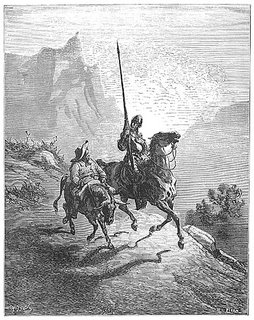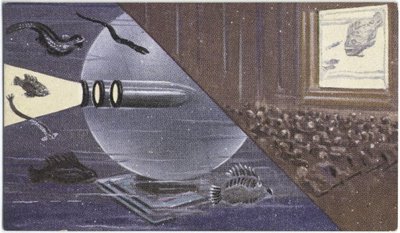McCarthy’s tendency for pastiche does more than invest his work with a literary gamesmanship. By pulling together an ever-shifting assemblage of references, he constructs the bones of his world while offering a critique of its sources. So while one may identify The Road’s preoccupation with the preference of suicide over rape and consumption by savages as one of the more virulently racist tropes of the classic “Indian-hating” western, its usage here imparts a new horror, even as it calls into question the over-arching metaphor of savagism. After all, in The Road, the savages are us. Likewise, when the title of Kris Kristofferson’s song “Please Don’t Tell Me How the Story Ends” pops up as the man ponders the fate of his son, it conveys a new poignancy, striking the reader as a wayward remnant of the pre-apocalypse. This is the effect of many of McCarthy’s borrowings in The Road. Unlike the playful vigor imparted by his pastiche-work in former novels, here it conveys a draining of vitality, as if these rags of meaning are all that remain to cover the naked desolation of the world he’s created. It is a beautifully achieved illusion, and a testament to the seamlessness of McCarthy’s craft.
Monday, October 23, 2006
These Rags of Meaning Are All That Remain to Cover the Naked Desolation
An excellent review of Cormac McCarthy's latest, The Road, by Benjamin Whitmer at The Modern Word. I particularly enjoyed this passage:
Osteographica: Historical Anatomies on the Web
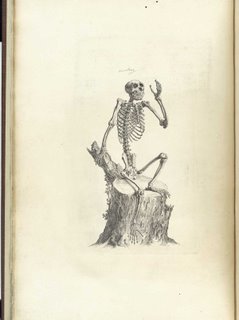 Author: Cheselden, William (1688-1752).
Author: Cheselden, William (1688-1752).Title: Osteographia, or The anatomy of the bones.
Publication Information: London: [William Bowyer], 1733.
While getting up to date on the always excellent, Giornale Nuovo, I clicked through to the National Library of Medicine's Historical Anatomies on the Web.
Images have been selected from the following anatomical atlases in the National Library of Medicine's collection. Each atlas is linked to a brief Author & Title Description, which offers an historical discussion of the work, its author, the artists, and the illustration technique. The Bibliographic Information link provides a bibliographical description of the atlas, so users will know which edition was scanned and if there are any characteristics special to the Library's copy.There is such a concentration of sublime imagery here (many featured prominently in the Dream Anatomy Online Exhibition) that you could almost choose at random to provide stunning examples. However, a few personal favorites:
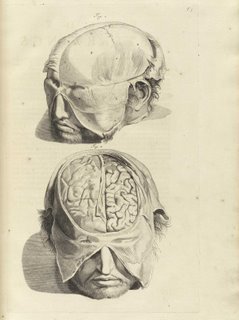 Author: Bidloo, Govard (1649 - 1713).
Author: Bidloo, Govard (1649 - 1713).Title: Ontleding des menschelyken lichaams.
Publication Information: Amsterdam: Weduwe van Joannes van Someren, et al., 1690.
 Author: Cowper, William (1666-1709).
Author: Cowper, William (1666-1709).Title: The anatomy of humane bodies.
Publication Information: Oxford :
Printed at the Theater, for Sam. Smith and Benj. Walford, 1698.
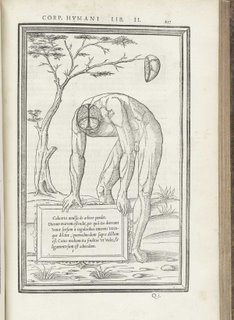 Author: Estienne, Charles (ca. 1504-ca. 1564).
Author: Estienne, Charles (ca. 1504-ca. 1564).Title: De dissectione partium corporis humani libri tres.
Publication Information: Paris: Simon Colinaeus, 1545.
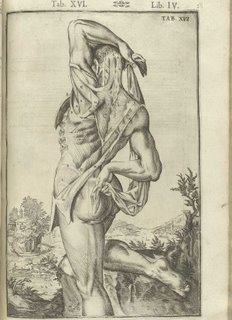 Author: Spiegel, Adriaan van (1578-1625) and Casseri, Giulio (ca. 1552-1616).
Author: Spiegel, Adriaan van (1578-1625) and Casseri, Giulio (ca. 1552-1616).Title: De formato foetu liber singularis.
Publication Information: Padua: Io. Bap. de Martinis & Livius Pasquatus, [1626].
Saturday, October 07, 2006
When the Pulse has been nailed upon the crossbeams.
From Edward Dahlberg's Can These Bones Live:
The critic is the Sancho Panza to his master, our Lord Don Quixote, the artist. Sancho is no bread, butter and beer realist. He too sees and knows with the magical folly of the heart that there is knowledge before reason and science, a secret wisdom that is prior to logic - the vibrant god-telling PULSE. "There are reasons of the heart of which Reason knows nothing," said Pascal.
There are no abstract truths - no Mass Man, no proletariat. There is only Man. When the Pulse has been nailed upon the crossbeams, lo, Reason gives up its viable breath and becomes a wandering ghostly Error. Truth and folly are ever about to expire, so that we, like our beloved Sancho Panza, kneeling at the deathbed of Don Quixote, must always be ready to receive the holy communion of cudgels and distaffs for the rebirth of the Pulse.
Sunday, October 01, 2006
Men in a bathysphere at sea-bed may transmit.
From a post on gmtplus9 about cigarette cards to the amazing NYPL Digital Gallery and the Age of Power and Wonder Gallery:
 Aerodrome of the future.
Aerodrome of the future.
(published ca. 1935-1938)
 Captain Eyston's car 'Thunderbolt'.
Captain Eyston's car 'Thunderbolt'.
(published ca. 1935-1938)
And my favorite:
 What inspired copy-writer came up with this future-conjuring sentence:
What inspired copy-writer came up with this future-conjuring sentence:
 The Future of Radio. Illustration by Frank R. Paul,
The Future of Radio. Illustration by Frank R. Paul,
in Radio For All, Hugo Gernsback, 1922
 Doctor Hackensaw's Secrets. Illustration by Frank R. Paul,
Doctor Hackensaw's Secrets. Illustration by Frank R. Paul,
No. 12: The Secret of the Philosopher's Stone,
Science and Invention, Jan. 1923
 Aerodrome of the future.
Aerodrome of the future.(published ca. 1935-1938)
 Captain Eyston's car 'Thunderbolt'.
Captain Eyston's car 'Thunderbolt'.(published ca. 1935-1938)
 What inspired copy-writer came up with this future-conjuring sentence:
What inspired copy-writer came up with this future-conjuring sentence:Men in a bathysphere at sea-bed may transmit to the home set or to the cinema scenes taking place at the bottom of the ocean.Somewhere the skull of Hugo Gernsback is smiling. And then one thing lead to another and the Gallery of Frank R. Paul's Artwork
 The Future of Radio. Illustration by Frank R. Paul,
The Future of Radio. Illustration by Frank R. Paul,in Radio For All, Hugo Gernsback, 1922
 Doctor Hackensaw's Secrets. Illustration by Frank R. Paul,
Doctor Hackensaw's Secrets. Illustration by Frank R. Paul,No. 12: The Secret of the Philosopher's Stone,
Science and Invention, Jan. 1923
And of course, from William Gibson's classic short story, The Gernsback Continuum:
 Image of the Modern City
Image of the Modern City
from the set of the 1930 musical, Just Imagine.
From INVENTING MODERN:
AND CREATING AN UNEXPECTED FUTURE
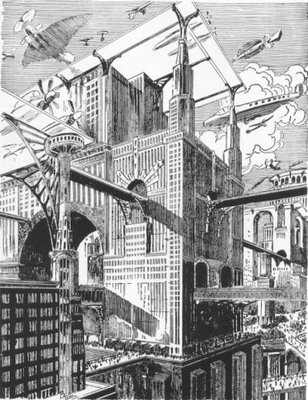 Image from a 1928 issue of Amazing Stories.
Image from a 1928 issue of Amazing Stories.
From INVENTING MODERN:
AND CREATING AN UNEXPECTED FUTURE
Then I looked behind me and saw the city. The books on Thirties design were in the trunk; one of them contained sketches of an idealized city that drew on Metropolis and Things to Come, but squared everything, soaring up through an architect's perfect clouds to zeppelin docks and mad neon spires. That city was a scale model of the one that rose behind me. Spire stood on spire in gleaming ziggurat steps that climbed to a central golden temple tower ringed with the crazy radiator flanges of the Mongo gas stations. You could hide the Empire State Building in the smallest of those towers. Roads of crystal soared between the spires, crossed and recrossed by smooth silver shapes like beads of running mercury. The air was thick with ships: giant wing-liners, little darting silver things (sometimes one of the quicksilver shapes from the sky bridges rose gracefully into the air and flew up to join the dance), mile-long blimps, hovering dragonfly things that were gyrocopters...
 Image of the Modern City
Image of the Modern Cityfrom the set of the 1930 musical, Just Imagine.
From INVENTING MODERN:
AND CREATING AN UNEXPECTED FUTURE
 Image from a 1928 issue of Amazing Stories.
Image from a 1928 issue of Amazing Stories.From INVENTING MODERN:
AND CREATING AN UNEXPECTED FUTURE
Subscribe to:
Posts (Atom)

